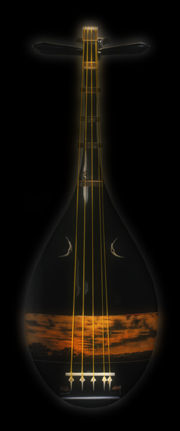 The origin of the Biwa (lute) were in ancient Iran and Arabia. Around the middle of the 6th century, Biwa was introduced to Japan through Korea and China with Buddhism. There are two kinds of Biwa that were introduced to Japan. One was Biwa for Japanese traditional music and dance as artistic music. This is called as "Gaku-Biwa", the other Biwa is "Moso-Biwa". "Moso" means "blind monk". Moso-Biwa was for religious music.
The origin of the Biwa (lute) were in ancient Iran and Arabia. Around the middle of the 6th century, Biwa was introduced to Japan through Korea and China with Buddhism. There are two kinds of Biwa that were introduced to Japan. One was Biwa for Japanese traditional music and dance as artistic music. This is called as "Gaku-Biwa", the other Biwa is "Moso-Biwa". "Moso" means "blind monk". Moso-Biwa was for religious music.
These two Biwa got Japanized and combined into "Heike-Biwa". On the other hand, Moso-Biwa was transformed into "Satsuma-Biwa".
Satsuma-Biwa developed in Satsuma, in southern Japan. Shimazu Nisshin (1492-1569), former lord of Satsuma state, created the lyrics and Fuchiwaki Juchoin, a blind monk, composed the music. The aim of Satsuma-Biwa to cultivate the samurai's mind. The pieces of Satsuma-Biwa were about the moral lessons of Buddhist religion and Confucianism. These lesson were simplified into lyrics by Shimazu Nisshin. Shimazu family was culturally and economically very wealthy. Shimazu set guidelines for samurai to be both a good warrior and a good scholar, so the family asked blind monks in their domain to teach Biwa for samurai.
Samurai spent their times in the forest and faced to themselves, and they made Biwa instrument by themselves. Therefore, the plectrum of Biwa changed its shape into a kind of weapon. The plectrum defended sword attack and was used as a boomerang.
With playing Biwa, samurai sang the sorrow story in old war time with their own interpretation. They played freely and expressed their own deep feeling. The sound of Biwa has its own unique sense of tension and it matched samurai's seriousness that never forgive the trick of senses.
The players of Satsuma-Biwa were samurai in Satsuma. With the advent of the warring states period in the late 16th century, the contents and expression of Satsuma-Biwa became more heroic. Therefore, the original lyrics of Shimazu Nisshin were so ethical, but the tone of the songs were changing to ones that expressed sorrows and outrage of their own. This playing style of Satsuma-Biwa was so dynamic and very characteristic among all the Biwa styles.
In the late Meiji era, around the beginning of the 20th century, Nagata Kinshin gave fineness and grace to Satsuma-Biwa. Nagata created his own style called "Kinshin-ryu". Furthermore, Satsuma-Biwa "Tsuru-ha" split away from Kinshin-ryu. This style is the newest one among Satsuma-Biwa. The founder of Tsuru-ha was Tsuruta Kinshi (1911-95). She started learning to play Satsuma-Biwa in her childhood. She took another good look at Satsuma-Biwa and explored the possibility as an instrument. Tsuruta tried to make an interpretation of the reason why samurai had required the Biwa. She recognized Satsuma-Biwa as a contemporary instrument and improved it. She created refined melodies and requested poets and authors to write the lyrics that matched to modern age. After the end of World War ll, she was appointed by Takemitsu Toru (1930-96), composer, and got a good reputation from playing Satsuma-Biwa with the bamboo flute player, Yokoyama Katsuya (1934-). Tsuruta and Yokoyama player music for television and movies, composed by Takemitsu. Especially, "November Steps", composed by Takemitsu, was a commissioned work for the New York Philharmonic, Tsuruta acquired international stature.
The features of Tsuru-ha are; seeking the beauty of music for songs and strings, and creating an ensemble style (historically Satsuma-Biwa was only in solo style). Tsuruta Kinshi is the only Biwa player who recollected Satsuma-Biwa, that contains samurai spirits, in modern age and enhanced the position of Biwa to the world standard.
Even though Tomoyoshi Kakushin is the seventh pupil of Tsuruta Kinshi, he is the only pupil who took over one of her Biwa instruments when she was still alive. Tomoyoshi is not particular about formalities, and flexibly responds to such changes in the times. As Tomoyoshi thinks that it is necessary to capture the audience, he is trying to introduce innovative approach "New Classics" to Satsuma-Biwa for passing down Satsuma-Biwa to next generation. Therefore, Tomoyoshi is very important young Satsuma-Biwa player. His powerful belief is supported by a lot of people, irrespective of national borders, categories and generation.
| |